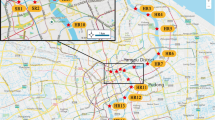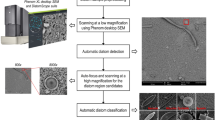Abstract
Diatom test is one of the commonly used diagnostic methods for drowning in forensic pathology, which provides supportive evidence for drowning. However, in forensic practice, it is time-consuming and laborious for forensic experts to classify and count diatoms, whereas artificial intelligence (AI) is superior to human experts in processing data and carrying out classification tasks. Some AI techniques have focused on searching diatoms and classifying diatoms. But, they either could not classify diatoms correctly or were time-consuming. Conventional detection deep network has been used to overcome these problems but failed to detect the occluded diatoms and the diatoms similar to the background heavily, which could lead to false positives or false negatives. In order to figure out the problems above, an improved region-based full convolutional network (R-FCN) with online hard example mining and the shape prior of diatoms was proposed. The online hard example mining (OHEM) was coupled with the R-FCN to boost the capacity of detecting the occluded diatoms and the diatoms similar to the background heavily and the priors of the shape of the common diatoms were explored and introduced to the anchor generation strategy of the region proposal network in the R-FCN to locate the diatoms precisely. The results showed that the proposed approach significantly outperforms several state-of-the-art methods and could detect the diatom precisely without missing the occluded diatoms and the diatoms similar to the background heavily. From the study, we could conclude that (1) the proposed model can locate the position and identify the genera of common diatoms more accurately; (2) this method can reduce the false positives or false negatives in forensic practice; and (3) it is a time-saving method and can be introduced.









Similar content being viewed by others
References
Piette MHA, Letter EAD (2006) Drowning: still a difficult autopsy diagnosis. Forensic Sci Int 163(1–2):1–9
Zhang P, Kang X, Zhang S et al (2020) The length and width of diatoms in drowning cases as the evidence of diatoms penetrating the alveoli-capillary barrier. Int J Legal Med 134(3):1037–1042
Lunetta P, Penttil A, Hällfors G (1998) Scanning and transmission electron microscopical evidence of the capacity of diatoms to penetrate the alveolo-capillary barrier in drowning. Int J Legal Med 111(5):229–237
Lunetta P, Modell JH (2005) Macroscopical, microscopical, and laboratory findings in drowning victims. In: Tsokos M (ed) Forensic pathology reviews, vol 3. Humana Press, Totowa
Rajvinder S, Rajinder S, Thakar MK (2006) Extraction methods of diatoms-a review. IIJFMT, 4(2)
Ming M, Meng X, Wang E (2007) Evaluation of four digestive methods for extracting diatoms. Forensic Sci Int 170(1):29–34
Zhao J, Liu C, He S et al (2013) Microwave digestion-vacuum filtration-automated scanning electron microscopy as a sensitive method for forensic diatom test. Int J Legal Med 127(2):459–463
Eiji K, Sonoda N, Shinkawa N et al (2019) A new enzymatic method for extracting diatoms from organs of suspected drowning cases using papain: optimal digestion and first practical application. Forensic Sci Int 297:204–216
Culverhouse P, Simpson R, Ellis R et al (1996) Automatic classification of field-collected dinoflagellates by artificial neural network. Mar Ecol Prog Ser 139(1–3):281–287
Zhou Y, Zhang J, Huang J et al (2019) Digital whole-slide image analysis for automated diatom test in forensic cases of drowning using a convolutional neural network algorithm. Forensic Sci Int 302:109922
Anibal P, Gloria B, Oscar D et al (2017) Automated diatom classification (part B): a deep learning approach. Appl Sci 7(5):460
Krause LMK, Koc J, Rosenhahn B et al (2020) A fully convolutional neural network for detection and counting of diatoms on coatings after short-term field exposure. Environ Sci Technol 54(16):10022–10030
Yu W, Xue Y, Knoops R et al (2020) Automated diatom searching in the digital scanning electron microscopy images of drowning cases using the deep neural networks. Int J Legal Med 135(2):497–508
Guiry MD (2012) How many species of algae are there? J Phycol 48(5):1057–1063
Mann DG, Vanormelingen P (2013) An inordinate fondness? The number, distributions, and origins of diatom species. J Eukaryot Microbiol 60:414–420
Zhao J, Wang Y, Zhang Y et al (2014) Types of diatoms in China’s three major rivers and the possible application for an automatic forensic diatom test. Aust J Forensic Sci 47(3):268–274
Eiji K, Shuji K, Masahiro S et al (2011) Numbers, sizes, and types of diatoms around estuaries for a diatom test. Am J Forensic Med Pathol 32(3):269–274
Gloria B, Oscar D, Anibal P et al (2017) Automated diatom classification (part A): handcrafted feature approaches. Appl Sci 7(8):753
Du Buf H (2002) Automatic diatom identification. World Scientific, Singapore
Dimitrovski I, Kocev D, Loskovska S et al (2012) Hierarchical classification of diatom images using ensembles of predictive clustering trees. Eco Inform 7(1):19–29
Deng J, Wang X, Zhao J et al (2019) Cyclotella recognition of high-resolution electron microscopy with complex background. Comput Eng Des 40:167–172
Liu W, Anguelov D, Erhan D et al (2016) Ssd: single shot multibox detector. European conference on computer vision, pp 21–37
Redmon J, Divvala S, Girshick R et al (2016) You only look once: unified, real-time object detection. Proceedings of 29th IEEE Conference on Computer Vision and Pattern Recognition, Las Vegas, Nevada, USA
Lin T, Goyal P, Girshick R (2017) Focal loss for dense object detection. Proceedings of 30th IEEE Conference on Computer Vision and Pattern Recognition, Honolulu, Hawaii, USA
Redmon J, Farhadi A (2017) YOLO9000: better, faster, stronger. Proceedings of 30th IEEE Conference on Computer Vision and Pattern Recognition, Honolulu, Hawaii, USA
Zhang S, Wen L, Bian X et al (2018) Single-shot refinement neural network for object detection. 2018 IEEE/CVF Conference on Computer Vision and Pattern Recognition
Ren S, He K, Girshick R et al (2015) Faster r-cnn: towards real-time object detection with region proposal networks. IEEE Trans Pattern Anal Mach Intell 39(6):1137–1149
He K, Gkioxari G, Dollár P et al (2017) Mask r-cnn. Proceedings of the IEEE international conference on computer vision, pp 2961–2969
Girshick R, Donahue J, Darrell T et al (2014) Rich feature hierarchies for accurate object detection and semantic segmentation. Proceedings of 27th IEEE Conference on Computer Vision and Pattern Recognition, Columbus, Ohio, USA
Girshick R (2015) Fast R-CNN. Proceedings of the2015IEEE International Conference on Computer Vision, Santiago, Chile
Dai J, Li Y, He K et al R-fcn: object detection via region-based fully convolutional networks Advances. Neural Information Processing System
Lin TY, Dollár P, Girshick R et al (2017) Lin T et al (2017) Feature pyramid networks for object detection. Proceedings of 30th IEEE Conference on Computer Vision and Pattern Recognition, Honolulu, Hawaii, USA
Si J, Lin J, Jiang F et al (2019) Hand-raising gesture detection in real classrooms using improved r-fcn. Neurocomputing 359:69–76
Shrivastava A, Gupta A, Girshick R (2016) Training region-based object detectors with online hard example mining, pp 761–769
Zhang X, Ren S, Sun J (2016) Deep residual learning for image recognition. Proceedings of 29th IEEE Conference on Computer Vision and Pattern Recognition, Las Vegas, Nevada, USA
Lecun Y, Boser B, Denker J et al (2014) Backpropagation applied to handwritten zip code recognition. Neural Comput 1(4):541–551
Everingham M, Van Gool L, Williams CK et al (2010) The pascal visual object classes (voc) challenge. Int J Comput Vis 88(2):303–338
Lin TY, Maire M, Belongie S et al (2014) Microsoft coco: common objects in context, pp 740–755
Jia Y, Shelhamer E, J, Donahue J et al (2014) Caffe: convolutional architecture for fast feature embedding, pp 675–678
Ludes B, Coste M, North N et al (1999) Diatom analysis in victim’s tissues as an indicator of the site of drowning. Int J Legal Med 112(3):163–166
Funding
This study was financially supported by the National Nature Science Foundation of China (61202267), Guangzhou Municipal Science and Technology Project (2019030001; 2019030012); Zhejiang Basic Public Welfare Research Plan Projects (LGG19F030009), and Grant-in Aids for Scientific Research from the Ministry of Public Security of the People’s Republic of China (2020GABJC38).
Author information
Authors and Affiliations
Corresponding authors
Ethics declarations
Ethical approval
Not applicable.
Informed consent
Not applicable.
Conflict of interest
The authors declare no competing interests.
Additional information
Publisher's note
Springer Nature remains neutral with regard to jurisdictional claims in published maps and institutional affiliations.
Rights and permissions
About this article
Cite this article
Deng, J., Guo, W., Zhao, Y. et al. Identification of diatom taxonomy by a combination of region-based full convolutional network, online hard example mining, and shape priors of diatoms. Int J Legal Med 135, 2519–2530 (2021). https://doi.org/10.1007/s00414-021-02664-2
Received:
Accepted:
Published:
Issue Date:
DOI: https://doi.org/10.1007/s00414-021-02664-2




